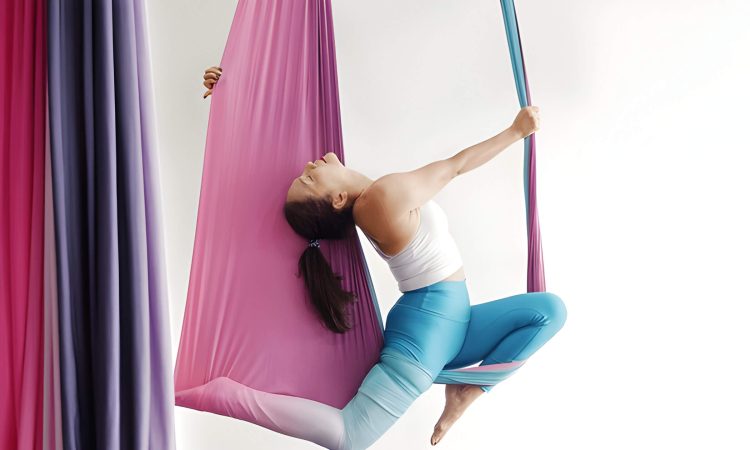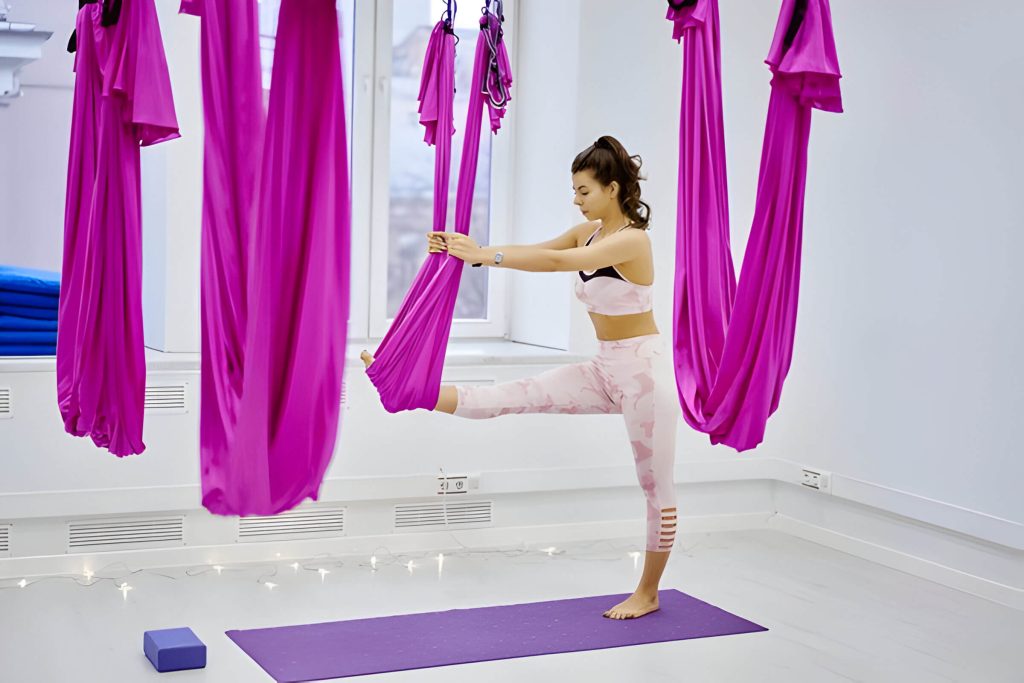
Imagine a yoga practice that enhances strength and flexibility while defying gravity. Welcome to aerial yoga, a blend of traditional poses, Pilates, and dance using a hammock. This innovative exercise improves posture, core strength, stress relief, and mindfulness. Whether you’re experienced or new to yoga, this guide introduces you to aerial yoga essentials: equipment, techniques, and tips for starting your floating fitness journey.
How Aerial Yoga Works (Equipment and Techniques)
Aerial yoga, an innovative blend of traditional yoga and aerial acrobatics, offers a unique way to enhance flexibility, strength, and mindfulness. Understanding the equipment and techniques involved is crucial for a safe and effective practice.
Aerial Yoga Equipment
The primary piece of equipment in aerial yoga is the hammock. Made from high-density nylon material, this hammock supports your body weight as you perform various poses suspended above the ground. The essential gear for aerial yoga also includes carabiners, daisy chains, and ceiling mounts to secure the hammock safely.
How to Do Aerial Yoga
Learning how to do aerial yoga starts with mastering basic poses like the cocoon or savasana in the hammock. These foundational techniques help you get comfortable with being airborne. As you progress, more advanced hammock techniques such as inversions and flips can be incorporated into your routine.
Safety Tips for Beginners
Safety is paramount when practicing aerial yoga. Beginners should ensure their aerial yoga equipment is properly installed by a professional. Always check that your hammock is securely fastened before each session. Additionally, it’s advisable to practice under the guidance of a certified instructor who can provide personalized safety tips and correct any improper form.
The Physical Benefits of Practicing Aerial Yoga Regularly

Aerial yoga, a unique blend of traditional yoga poses, Pilates, and dance with the use of a hammock or silk fabric, offers numerous physical benefits that go beyond conventional mat-based practices. One of the most notable advantages is the enhancement of strength and flexibility. The support provided by the hammock allows practitioners to achieve deeper stretches and more challenging poses without putting undue stress on their joints. This not only increases muscle strength but also significantly improves overall flexibility.
Additionally, aerial yoga is highly effective for improving posture. The hammock exercises encourage proper alignment and spinal decompression, which can alleviate back pain and correct postural imbalances caused by prolonged sitting or poor ergonomics. By regularly engaging in these exercises, individuals can develop a stronger core and better posture over time.
Another significant benefit of aerial yoga is its impact on core strength. Many aerial poses require substantial engagement of the abdominal muscles to maintain balance and stability in mid-air. This constant activation provides an intense core workout that can lead to improved muscle tone and endurance in the abdominal region.
In summary, practicing aerial yoga regularly offers a comprehensive workout that enhances strength, flexibility, posture, and core stability. These physical benefits make it an excellent addition to any fitness routine for those looking to improve their overall well-being through innovative exercise methods.
Mental Health Advantages
Aerial yoga, also known as anti-gravity yoga, offers numerous mental health benefits that go beyond the physical advantages of traditional yoga. One of the primary mental health benefits of aerial yoga is stress relief. By practicing stress relief exercises in the air, individuals can experience a unique form of relaxation and decompression. The sensation of being suspended in hammocks allows for a gentle release of tension from the body, which can significantly reduce stress levels.
Moreover, mindfulness through movement in hammocks is another key advantage of aerial yoga. The practice requires a heightened sense of awareness and concentration as you move through various poses while suspended. This focus helps to quiet the mind and promotes a state of mindfulness, making it easier to stay present and attuned to your body’s sensations.
Incorporating aerial yoga into your routine can therefore be an effective way to enhance your mental well-being. Whether you’re looking for an innovative method to alleviate stress or seeking new ways to practice mindfulness, aerial yoga provides a unique and beneficial approach that combines physical activity with mental tranquility.
Aerial Yoga vs Traditional Yoga (Key Differences and Similarities)
The practice of yoga has evolved over centuries, and today, it offers a variety of styles to suit different preferences and fitness levels. Among these, aerial yoga and traditional yoga stand out for their unique approaches to achieving physical and mental well-being. Understanding the key differences and similarities between these two forms can help practitioners choose the right style for their needs.
Differences Between Floor and Air-Based Yoga Practices
Traditional yoga is practiced on a mat placed on the floor, utilizing various postures (asanas), breathing techniques (pranayama), and meditation to enhance flexibility, strength, balance, and mindfulness. Aerial yoga, on the other hand, incorporates a hammock or silk fabric suspended from the ceiling to support the body in different poses. This air-based practice allows for greater freedom of movement and can reduce strain on joints by distributing body weight across the fabric.
Unique Aspects of Anti-Gravity Workouts
One of the most notable aspects of aerial yoga is its anti-gravity component. The use of hammocks enables practitioners to perform inversions with ease, which can decompress the spine and improve circulation without putting pressure on the head or neck. This aspect makes aerial yoga particularly beneficial for those looking to alleviate back pain or enhance spinal health.
Similarities in Benefits
Despite their differences in execution, both aerial yoga and traditional yoga share several benefits. Both practices aim to improve overall physical fitness by increasing strength, flexibility, balance, and coordination. Additionally, they promote mental clarity through focused breathing techniques and mindfulness exercises that reduce stress levels.
In conclusion, while there are distinct differences between aerial vs traditional yoga practices—such as their approach to poses (floor-based versus air-based) and unique benefits like anti-gravity workouts—both forms offer valuable health benefits that cater to diverse needs. Whether you prefer grounding yourself with traditional floor exercises or exploring new heights with an aerial hammock depends on your personal fitness goals and comfort level.
Tips for Your First Aerial Yoga Class
Aerial yoga is an exciting and unique way to enhance your fitness routine, combining traditional yoga poses with the support of a silk hammock. If you’re gearing up for your first aerial yoga class, here are some essential tips to help you get started.
1. Aerial Yoga Beginner Tips
As a beginner, it’s important to approach aerial yoga with an open mind and readiness to learn. Start by familiarizing yourself with basic poses and terms used in aerial yoga. Don’t hesitate to ask questions during your class; instructors are there to guide you through the process safely.
2. First Class Preparation
Preparation is key for a successful first experience. Arrive at least 15 minutes early to acquaint yourself with the studio environment and meet your instructor. Ensure you’ve eaten lightly before class; a heavy meal can make inversions uncomfortable.
3. What to Wear for Aerial Fitness
Choosing the right attire is crucial for comfort and safety in aerial yoga. Opt for form-fitting clothes that cover your legs and underarms, this helps prevent fabric burns from the hammock. Avoid wearing jewelry or clothing with zippers that could snag on the silk.
4. Finding Local Classes
To find local aerial yoga classes, start by searching online directories or fitness apps that list nearby studios offering this type of workout. Reading reviews and seeking recommendations from friends can also help you find reputable instructors who prioritize safety.
5. Starting Your Practice at Home
If attending a studio isn’t feasible, consider starting your practice at home once you’ve gained some initial experience in a class setting. Invest in high-quality equipment designed specifically for aerial fitness, ensuring it’s securely installed according to manufacturer guidelines.
By following these tips, you’ll be well-prepared for your first aerial yoga class and ready to enjoy all the benefits this innovative practice has to offer!
Conclusion- Start Your Journey with Aerial Yoga Today!
Aerial yoga, an innovative and transformative practice, has been gaining popularity for its unique approach to fitness and well-being. By combining traditional yoga poses with the use of a suspended hammock, aerial yoga offers a range of benefits that go beyond the mat. From enhancing flexibility and strength to improving mental clarity and reducing stress, this practice provides a holistic workout for both body and mind.
One of the standout features of aerial yoga is its ability to make challenging poses more accessible. The support of the hammock allows practitioners to explore deeper stretches and inversions with greater ease and safety. This not only builds confidence but also helps in overcoming fear associated with complex movements.
Moreover, aerial yoga promotes spinal decompression, which can alleviate back pain and improve posture. The gentle traction created by hanging upside down relieves pressure on the spine, providing relief to those who spend long hours sitting or standing.
In addition to physical benefits, aerial yoga fosters mental relaxation. The meditative aspect of floating in the air encourages mindfulness and presence, helping practitioners disconnect from daily stresses. This combination of physical exertion and mental calmness makes aerial yoga a comprehensive practice for overall well-being.
As you consider incorporating aerial yoga into your fitness routine, remember that it’s suitable for all levels, from beginners to advanced yogis. With professional guidance from certified instructors, you can safely embark on this exhilarating journey.
Embrace the sky today; let aerial yoga elevate your fitness experience to new heights!


